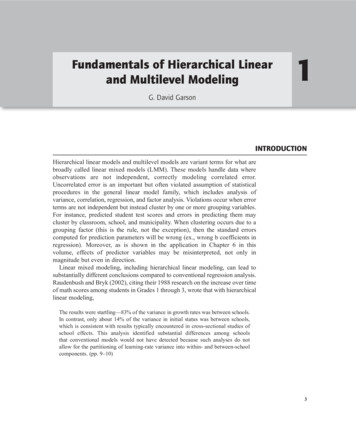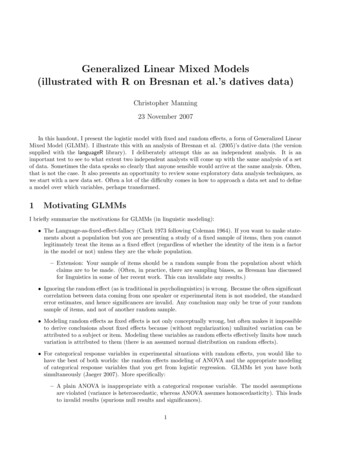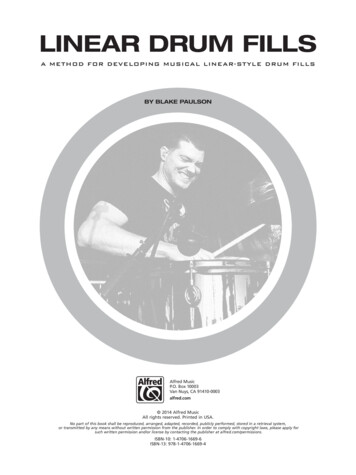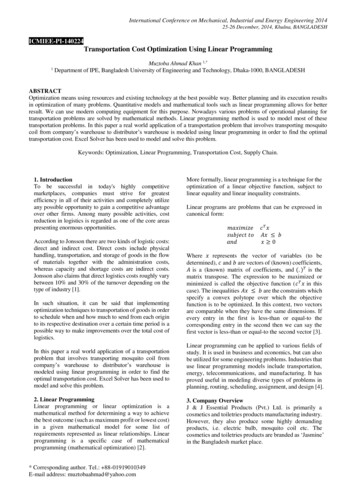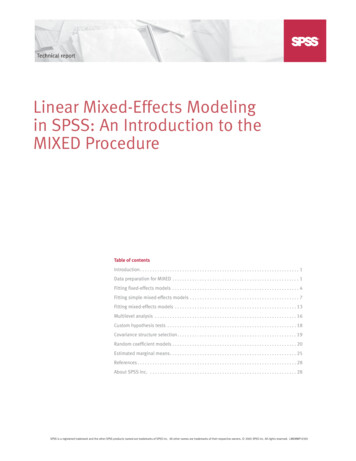
Transcription
Technical reportLinear Mixed-Effects Modelingin SPSS: An Introduction to theMIXED ProcedureTable of contentsIntroduction. . . . . . . . . . . . . . . . . . . . . . . . . . . . . . . . . . . . . . . . . . . . . . . . . . . . . . . . . . . . . . . . 1Data preparation for MIXED . . . . . . . . . . . . . . . . . . . . . . . . . . . . . . . . . . . . . . . . . . . . . . . . . . . 1Fitting fixed-effects models . . . . . . . . . . . . . . . . . . . . . . . . . . . . . . . . . . . . . . . . . . . . . . . . . . . 4Fitting simple mixed-effects models . . . . . . . . . . . . . . . . . . . . . . . . . . . . . . . . . . . . . . . . . . . . 7Fitting mixed-effects models . . . . . . . . . . . . . . . . . . . . . . . . . . . . . . . . . . . . . . . . . . . . . . . . . 13Multilevel analysis . . . . . . . . . . . . . . . . . . . . . . . . . . . . . . . . . . . . . . . . . . . . . . . . . . . . . . . . . 16Custom hypothesis tests . . . . . . . . . . . . . . . . . . . . . . . . . . . . . . . . . . . . . . . . . . . . . . . . . . . . 18Covariance structure selection. . . . . . . . . . . . . . . . . . . . . . . . . . . . . . . . . . . . . . . . . . . . . . . . 19Random coefficient models . . . . . . . . . . . . . . . . . . . . . . . . . . . . . . . . . . . . . . . . . . . . . . . . . . 20Estimated marginal means. . . . . . . . . . . . . . . . . . . . . . . . . . . . . . . . . . . . . . . . . . . . . . . . . . . 25References . . . . . . . . . . . . . . . . . . . . . . . . . . . . . . . . . . . . . . . . . . . . . . . . . . . . . . . . . . . . . . . . 28About SPSS Inc. . . . . . . . . . . . . . . . . . . . . . . . . . . . . . . . . . . . . . . . . . . . . . . . . . . . . . . . . . . . 28SPSS is a registered trademark and the other SPSS products named are trademarks of SPSS Inc. All other names are trademarks of their respective owners. 2005 SPSS Inc. All rights reserved. LMEMWP-0305
IntroductionThe linear mixed-effects models (MIXED) procedure in SPSS enables you to fit linear mixed-effects models to data sampledfrom normal distributions. Recent texts, such as those by McCulloch and Searle (2000) and Verbeke and Molenberghs(2000), comprehensively review mixed-effects models. The MIXED procedure fits models more general than those of thegeneral linear model (GLM) procedure and it encompasses all models in the variance components (VARCOMP) procedure.This report illustrates the types of models that MIXED handles. We begin with an explanation of simple models that can befitted using GLM and VARCOMP, to show how they are translated into MIXED. We then proceed to fit models that are uniqueto MIXED.The major capabilities that differentiate MIXED from GLM are that MIXED handles correlated data and unequal variances.Correlated data are very common in such situations as repeated measurements of survey respondents or experimentalsubjects. MIXED extends repeated measures models in GLM to allow an unequal number of repetitions. It also handles morecomplex situations in which experimental units are nested in a hierarchy. MIXED can, for example, process data obtainedfrom a sample of students selected from a sample of schools in a district.In a linear mixed-effects model, responses from a subject are thought to be the sum (linear) of so-called fixed and randomeffects. If an effect, such as a medical treatment, affects the population mean, it is fixed. If an effect is associated with asampling procedure (e.g., subject effect), it is random. In a mixed-effects model, random effects contribute only to thecovariance structure of the data. The presence of random effects, however, often introduces correlations between cases aswell. Though the fixed effect is the primary interest in most studies or experiments, it is necessary to adjust for the covariancestructure of the data. The adjustment made in procedures like GLM-Univariate is often not appropriate because it assumesindependence of the data.The MIXED procedure solves these problems by providing the tools necessary to estimate fixed and random effects in onemodel. MIXED is based, furthermore, on maximum likelihood (ML) and restricted maximum likelihood (REML) methods, versusthe analysis of variance (ANOVA) methods in GLM. ANOVA methods produce an optimum estimator (minimum variance) forbalanced designs, whereas ML and REML yield asymptotically efficient estimators for balanced and unbalanced designs. MLand REML thus present a clear advantage over ANOVA methods in modeling real data, since data are often unbalanced. Theasymptotic normality of ML and REML estimators, furthermore, conveniently allows us to make inferences on the covarianceparameters of the model, which is difficult to do in GLM.Data preparation for MIXEDMany datasets store repeated observations ona sample of subjects in “one subject per row”format. MIXED, however, expects thatobservations from a subject are encoded inseparate rows. To illustrate, we select a subsetof cases from the data that appear in Potthoffand Roy (1964). The data shown in Figure 1encode, in one row, three repeated measurementsof a dependent variable (“dist1” to “dist3”) froma subject observed at different ages (“age1” toFigure 1. MIXED,however, requiresthat measurements atdifferent ages be collapsedinto one variable, so thateach subject has three cases.The Data Restructure Wizardin SPSS simplifies the tediousdata conversion process. Wechoose “Data- Restructure”from the pull-down menu,and select the option“Restructure selectedvariables into cases.” Wethen click the “Next” buttonto reach the dialog shownin Figure 2.“age3”).1Linear Mixed-Effects Modeling in SPSS
Figure 2. We need to convert two groups ofvariables (“age” and “dist”) into cases. Wetherefore enter “2” and click “Next.” Thisbrings us to the “Select Variables” dialog box.Figure 3. In the “Select Variables” dialog box,we first specify “Subject ID [subid]” as the casegroup identification. We then enter the namesof new variables in the target variable dropdown list. For the target variable “age,” we drag“age1,” “age2,” and “age3” to the list box in the“Variables to be Transposed” group. We similarlyassociate variables “dist1,” “dist2,” and “dist3”with the target variable “distance.” We then dragvariables that do not vary within a subject to the“Fixed Variable(s)” box. Clicking “Next” bringsus to the “Create Index Variables” dialog box.We accept the default of one index variable, thenclick “Next” to arrive at the final dialog box.Linear Mixed-Effects Modeling in SPSS2
Figure 4. In the “Create One Index Variable”dialog box, we enter “visit” as the name ofthe indexing variable and click “Finish.”Figure 5. We now have three cases foreach subject.3Linear Mixed-Effects Modeling in SPSS
We can also perform the conversion using the following command syntax:VARSTOCASES/MAKE age FROM age1 age2 age3/MAKE distance FROM dist1 dist2 dist3/INDEX visit(3)/KEEP subid gender.The command syntax is easy to interpret—it collapses the three age variables into “age” and the three response variablesinto “distance.” At the same time, a new variable, “visit,” is created to index the three new cases within each subject. Thelast subcommand means that the two variables that are constant within a subject should be kept.Fitting fixed-effects modelsWith iid residual errorsA fitted model has the formvector of fixed-effects parameters and, where, whereis a vector of responses,is the fixed-effects design matrix,is a vector of residual errors. In this model, we assume thatis an unknown covariance matrix. A common belief is thatis ais distributed as. We can use GLM or MIXED tofit a model with this assumption. Using a subset of the growth study dataset, we illustrate how to use MIXED to fit a fixedeffects model. The following command (Example 1) fits a fixed-effects model that investigates the effect of the variables“gender” and “age” on “distance,” which is a measure of the growth rate.Example 1: Fixed-effects model using MIXEDCommand syntax:MIXED DISTANCE BY GENDER WITH AGE/FIXED GENDER AGE SSTYPE(3)/PRINT SOLUTION TESTCOV.Output:Figure 6Figure 7Linear Mixed-Effects Modeling in SPSS4
The command in Example 1 produces a “Type III Testsof Fixed Effects” table (Figure 6). Both “gender” and“age” are significant at the .05 level. This meansthat “gender” and “age” are potentially important predictors of the dependent variable. Moredetailed information on fixed-effects parametersmay be obtained by using the subcommand /PRINTSOLUTION. The “Estimates of Fixed Effects” table(Figure 7) gives estimates of individual parameters,Figure 8as well as their standard errors and confidence intervals.We can see that the mean distance for males is larger than that for females. Distance, moreover, increases with age. MIXEDalso produces an estimate of the residual error variance and its standard error. The /PRINT TESTCOV option gives us the Waldstatistic and the confidence interval for the residual error variance estimate.Example 1 is simple—users familiar with the GLM procedure can fit the same model using GLM.Example 2: Fixed-effects model using GLMCommand syntax:GLM DISTANCE BY GENDER WITH AGE/METHOD SSTYPE(3)/PRINT PARAMETER/DESIGN GENDER AGE.Output:Figure 95Linear Mixed-Effects Modeling in SPSS
We see in Figure 9 that GLM and MIXEDproduced the same Type III tests andparameter estimates. Note, however,that in the MIXED “Type III Tests of FixedEffects” table (Figure 6), there is nocolumn for the sum of squares. This isbecause, for some complex models,the test statistics in MIXED may not beexpressed as a ratio of two sums ofsquares. They are thus omitted from theFigure 10ANOVA table.With non-iid residual errorsThe assumption may be violated in some situations. This often happens when repeated measurements are made on eachsubject. In the growth study dataset, for example, the response variable of each subject is measured at various ages. Wemay suspect that error terms within a subject are correlated. A reasonable choice of the residual error covariance will thereforebe a block diagonal matrix, where each block is a first-order autoregressive (AR1) covariance matrix.Example 3: Fixed-effects model with correlated residual errorsCommand syntax:MIXED DISTANCE BY GENDER WITH AGE/FIXED GENDER AGE/REPEATED VISIT SUBJECT(SUBID) COVTYPE(AR1)/PRINT SOLUTION TESTCOV R.Output:Figure 11Figure 12Linear Mixed-Effects Modeling in SPSS6
Figure 13Example 3 uses the /REPEATED subcommand to specify a more generalcovariance structure for the residual errors. Since there are threeobservations per subject, we assume that the set of three residualerrors for each subject is a sample from a three-dimensional normaldistribution with a first-order autoregressive (AR1) covariance matrix.Residual errors within each subject are therefore correlated, but areindependent across subjects. The MIXED procedure, by default, usesthe REML method to estimate the covariance matrix. An alternative isFigure 14to request ML estimates by using the /METHOD ML subcommand.The command syntax in Example 3 also produces the “Residual Covariance (R) Matrix” (Figure 14), which shows the estimatedcovariance matrix of the residual error for one subject. We see from the “Estimates of Covariance Parameters” table (Figure 13)that the correlation parameter has a relatively large value (.729) and that the p-value of the Wald test is less than .05. Theautoregressive structure may fit the data better than the model in Example 1.We also see that, for the tests of fixed effects, the denominator degrees of freedom are not integers. This is because thesestatistics do not have exact F distributions. The values for denominator degrees of freedom are obtained by a Satterthwaiteapproximation. We see in the new model that gender is not significant at the .05 level. This demonstrates that ignoring thepossible correlations in your data may lead to incorrect conclusions. MIXED is therefore usually a better alternative to GLMand VARCOMP when data are correlated.Fitting simple mixed-effects modelsBalanced designMIXED, as its name implies, handles complicated models that involve fixed and random effects. Levels of an effect are, insome situations, only a sample of all possible levels. If we want to study the efficiency of workers in different environments,for example, we don’t need to include all workers in the study—a sample of workers is usually enough. The worker effectshould be considered random, due to the sampling process. A mixed-effects model has, in general, the formwhere the extra termmodels the random effects.is the design matrix of random effects andis a vector of random-effects parameters. We can use GLM and MIXED to fit mixed-effects models. MIXED, however, fits a much wider class ofmodels. To understand the functionality of MIXED, we first look at several simpler models that can be created in MIXED andGLM. We also look at the similarity between MIXED and VARCOMP in these models.7Linear Mixed-Effects Modeling in SPSS
In examples 4 through 6, we use a semiconductor dataset that appeared in Pinheiro and Bates (2000) to illustrate the similaritybetween GLM, MIXED, and VARCOMP. The dependent variable in this dataset is “current” and the predictor is “voltage.” Thedata are collected from a sample of ten silicon wafers. There are eight sites on each wafer and five measurements are takenat each site. We have, therefore, a total of 400 observations and a balanced design.Example 4: Simple mixed-effects model with balanced design using MIXEDCommand syntax:MIXED CURRENT BY WAFER WITH VOLTAGE/FIXED VOLTAGE SSTYPE(3)/RANDOM WAFER/PRINT SOLUTION TESTCOV.Output:Figure 15Figure 16Figure 17Linear Mixed-Effects Modeling in SPSS8
Example 5: Simple mixed-effects model with balanced design using GLMCommand syntax:GLM CURRENT BY WAFER WITH VOLTAGE/RANDOM WAFER/METHOD SSTYPE(3)/PRINT PARAMETER/DESIGN WAFER VOLTAGE.Output:Figure 18Figure 19Example 6: Variance components model with balanced designCommand syntax:VARCOMP CURRENT BY WAFER WITH VOLTAGE/RANDOM WAFER/METHOD REML.Output:In Example 4, “voltage” is entered as a fixed effect and “wafer” isentered as a random effect. This example tries to model the relationshipbetween “current” and “voltage” using a straight line, but the interceptof the regression line will vary from wafer to wafer according to a normaldistribution. In the Type III tests for “voltage,” we see a significantFigure 20relationship between “current” and “voltage.” If we delve deeper into theparameter estimates table, the regression coefficient of “voltage” is 9.65.This indicates a positive relationship between “current” and “voltage.”In the “Estimates of Covariance Parameters” table (Figure 17), we haveestimates for the residual error variance and the variance due to thesampling of wafers.9Linear Mixed-Effects Modeling in SPSS
We repeat the same model in Example 5 using GLM. Note that MIXED produces Type III tests for fixed effects only, but GLMincludes fixed and random effects. GLM treats all effects as fixed during computation and constructs F statistics by taking theratio of the appropriate sums of squares. Mean squares of random effects in GLM are estimates of functions of the varianceparameters of random and residual effects. These functions can be recovered from “Expected Mean Squares” (Figure 19). InMIXED, the outputs are much simpler because the variance parameters are estimated directly using ML or REML. As a result,there are no random-effect sums of squares.When we have a balanced design, as in examples 4 through 6, the tests of fixed effects are the same for GLM and MIXED. Wecan also recover the variance parameter estimates of MIXED by using the sum of squares in GLM. In MIXED, for example, theestimate of the residual variance is 0.175, which is the same as the MS(Error) in GLM. The variance estimate of random effect“wafer” is 0.093, which can be recovered in GLM using the “Expected Mean Squares” table (Figure 19) in Example 5:Var(WAFER) [MS(WAFER)-MS(Error)]/40 0.093This is equal to MIXED’s estimate. One drawback of GLM, however, is that you cannot compute the standard error of thevariance estimates.VARCOMP is, in fact, a subset of MIXED. These two procedures therefore always provide the same variance estimates, as seenin examples 4 and 6. VARCOMP only fits relatively simple models. It can only handle random effects that are iid. No statisticson fixed effects are produced. If your primary objective is to make inferences about fixed effects and your data are correlated,MIXED is a better choice.An important note: Due to the different estimation methods that are used, GLM and MIXED often do not produce the sameresults. The next section gives an example of situations in which they produce different results.Unbalanced designOne situation in which MIXED and GLM disagree is with an unbalanced design. To illustrate this, we removed some cases inthe semiconductor dataset, so that the design is no longer balanced.Figure 21Linear Mixed-Effects Modeling in SPSS10
We then rerun examples 4 through 6 with this unbalanced dataset. The output is shown in examples 4a through 6a. We wantto see whether the three methods—GLM, MIXED and VARCOMP—still agree with each other.Example 4a: Mixed-effects model with unbalanced design using MIXEDCommand syntax:MIXED CURRENT BY WAFER WITH VOLTAGE/FIXED VOLTAGE SSTYPE(3)/RANDOM WAFER/PRINT SOLUTION TESTCOV.Output:Figure 22Figure 23Figure 24Example 5a: Mixed-effects model with unbalanced design using GLMCommand syntax:GLM CURRENT BY WAFER WITH VOLTAGE/RANDOM WAFER/METHOD SSTYPE(3)/PRINT PARAMETER/DESIGN WAFER VOLTAGE.11Linear Mixed-Effects Modeling in SPSS
Output:Figure 25Figure 26Example 6a: Variance components model with unbalanced designCommand syntax:VARCOMP CURRENT BY WAFER WITH VOLTAGE/RANDOM WAFER/METHOD REML.Output:Since the data have changed, we expect examples 4a through 6a to differfrom examples 4 through 6. We will focus instead on whether examples 4a,5a, and 6a agree with each other.In Example 4a, the F statistic for the “voltage” effect is 67481.118, butFigure 27Example 5a gives an F statistic value of 67482.629. Apart from the test offixed effects, we also see a difference in covariance parameter estimates.Examples 4a and 6a, however, show that VARCOMP and MIXED can produce the same variance estimates, even in anunbalanced design. This is because MIXED and VARCOMP offer maximum likelihood or restricted maximum likelihoodmethods in estimation, while GLM estimates are based on the method-of-moments approach.MIXED is generally preferred because it is asymptotically efficient (minimum variance), whether or not the data are balanced.GLM, however, only achieves its optimum behavior when the data are balanced.Linear Mixed-Effects Modeling in SPSS12
Fitting mixed-effects modelsWith subjectsIn the semiconductor dataset, “current” is a dependent variable measured on a batch of wafers. These wafers are thereforeconsidered subjects in a study. An effect of interest (such as “site”) may often vary with subjects (“wafer”). One scenario isthat the (population) means of “current” at separate sites are different. When we look at the current measured at these siteson individual wafers, however, they hover below or above the population mean according to some normal distribution. It istherefore common to enter an “effect by subject” interaction term in a GLM or MIXED model to account for the subject variations.In the dataset there are eight sites and ten wafers. The site*wafer effect, therefore, has 80 parameters, which can be denotedby, i 1.10 and j 1.8. A common assumption is thatunknown variance. The mean is zero because’s are assumed to be iid normal with zero mean and an’s are used to model only the population variation. The mean of thepopulation is modeled by entering “site” as a fixed effect in GLM and MIXED. The results of this model for MIXED and GLMare shown in examples 7 and 8.Example 7: Fitting random effect*subject interaction using MIXEDCommand syntax:MIXED CURRENT BY WAFER SITE WITH VOLTAGE/FIXED SITE VOLTAGE SSTYPE(3)/RANDOM SITE*WAFER COVTYPE(ID).Output:Figure 28Figure 2913Linear Mixed-Effects Modeling in SPSS
Example 8: Fitting random effect*subject interaction using GLMCommand syntax:GLM CURRENT BY WAFER SITE WITH VOLTAGE/RANDOM WAFER/METHOD SSTYPE(3)/DESIGN SITE SITE*WAFER VOLTAGE.Output:Figure 30Figure 31Since the design is balanced, the results of GLM and MIXED in examples 7 and 8 match. This is similar to examples 4 and 5.We see from the results of Type III tests that “voltage” is still an important predictor of “current,” while “site” is not. The meancurrents at different sites are thus not significantly different from each other, so we can use a simpler model without the fixedeffect “site.” We should still, however, consider a random-effects model, because ignoring the subject variation may lead toincorrect standard error estimates of fixed effects or false significant tests.Up to this point, we examined primarily the similarities between GLM and MIXED. MIXED, in fact, has a much more flexible wayof modeling random effects. Using the SUBJECT and COVTYPE options, Example 9 presents an equivalent form of Example 7.Example 9: Fitting random effect*subject interaction using SUBJECT specificationCommand syntax:MIXED CURRENT BY SITE WITH VOLTAGE/FIXED SITE VOLTAGE SSTYPE(3)/RANDOM SITE SUBJECT(WAFER) COVTYPE(ID).Linear Mixed-Effects Modeling in SPSS14
The SUBJECT option tells MIXED that each subject will have its own set of random parameters for the random effect “site.”The COVTYPE option will specify the form of the variance covariance matrix of the random parameters within one subject.The command syntax attempts to specify the distributional assumption in a multivariate form, which can be written as:Figure 32Under normality, this assumption is equivalent to that in Example 7. One advantage of the multivariate form is that you can easilyspecify other covariance structures by using the COVTYPE option. The flexibility in specifying covariance structures helps us tofit a model that better describes the data. If, for example, we believe that the variances of different sites are different, we canspecify a diagonal matrix as covariance type and the assumption becomes:Figure 33The result of fitting the same model using this assumption is given in Example 10.Example 10: Using COVTYPE in a random-effects modelCommand syntax:MIXED CURRENT BY SITE WITH VOLTAGE/FIXED SITE VOLTAGE SSTYPE(3)/RANDOM SITE SUBJECT(WAFER) COVTYPE(DIAG)/PRINT G TESTCOV.Output:Figure 3415Linear Mixed-Effects Modeling in SPSS
In Example 10, we request one extra table, theestimated covariance matrix of the randomeffect “site.” It is an eight-by-eight diagonalmatrix in this case. Note that changing thecovariance structure of a random effect alsochanges the estimates and tests of fixedeffects. We want, in practice, an objectivemethod to select suitable covariance structures for our random effects. In the section“Covariance Structure Selection,” we revisitexamples 9 and 10 to show how to selectFigure 35covariance structures for random effects.Multilevel analysisThe use of the SUBJECT and COVTYPE optionsin /RANDOM and /REPEATED brings manyoptions for modeling the covariance structuresof random effects and residual errors. It isparticularly useful when modeling dataobtained from a hierarchy. Example 11illustrates the simultaneous use of theseFigure 36options in a multilevel model. We selecteddata from six schools from the Junior SchoolProject of Mortimore, et al. (1988). We investigate below how the socioeconomic status (SES)of a student affects his or her math scores overa three-year period.Example 11: Multilevel mixed-effects modelCommand syntax:MIXED MATHTEST BY SCHOOL CLASS STUDENT GENDER SES SCHLYEAR/FIXED GENDER SES SCHLYEAR SCHOOL/RANDOM SES SUBJECT(SCHOOL*CLASS) COVTYPE(ID)/RANDOM SES SUBJECT(SCHOOL*CLASS*STUDENT) COVTYPE(ID)/REPEATED SCHLYEAR SUBJECT(SCHOOL*CLASS*STUDENT) COVTYPE(AR1)/PRINT SOLUTION TESTCOV.Output:Linear Mixed-Effects Modeling in SPSSFigure 3716
Figure 38Figure 39In Example 11, the goal is to discover whether socioeconomic status (“ses”) is an important predictor for mathematicsachievement (“mathtest”). To do so, we use the factor “ses” as a fixed effect. We also want to adjust for the possiblesampling variation due to different classes and students. “Ses” is therefore also used twice as a random effect. The firstrandom effect tries to adjust for the variation of the “ses” effect owing to class variation. In order to identify all classes inthe dataset, school*class is specified in the SUBJECT option. The second random effect also tries to adjust for the variationof the “ses” effect owing to student variation. The subject specification is thus school*class*student. All of the students arefollowed for three years; the school year (“schlyear”) is therefore used as a fixed effect to adjust for possible trends in thisperiod. The /REPEATED subcommand is also used to model the possible correlation of the residual errors within each student.We have a relatively small dataset. Since there are only six schools, we can only use school as a fixed effect while adjustingfor possible differences between schools. In this example, there is only one random effect at each level. With SPSS 11.5 orlater, you can specify more than one random effect in MIXED. If multiple random effects are specified on the same RANDOMsubcommand, you can model their correlation by using a suitable COVTYPE specification. If the random effects are specifiedon separate RANDOM subcommands, they are assumed to be independent.17Linear Mixed-Effects Modeling in SPSS
In the Type III tests of fixed effects, in Example 11, we see that socioeconomic status does impact student performance. Theparameter estimates of “ses” for students with “ses 1” (fathers have managerial or professional occupations) indicate thatthese students perform better than students at other socioeconomic levels. The effect “schlyear” is also significant in themodel and the students’ performances increase with “schlyear.”From “Estimates of Covariance Parameters” (Figure 39), we notice that the estimate of the “AR1 rho” parameter is notsignificant, which means that a simple, scaled-identity structure may be used. For the variation of “ses” due to school*class, the estimate is very small compared to other sources of variance and the Wald test indicates that it is not significant.We can therefore consider removing the random effect from the model.We see from this example that the major advantages of MIXED are that it is able to look at different aspects of a datasetsimultaneously and that all of the statistics are already adjusted for all effects in the model. Without MIXED, we must usedifferent tools to study different aspects of the models. An example of this is using GLM to study the fixed effects andusing VARCOMP to study the covariance structure. This is not only time consuming, but the assumptions behind the statisticsare usually violated.Custom hypothesis testsApart from predefined statistics, MIXED allows users to construct custom hypotheses on fixed- and random-effects parametersthrough the use of the /TEST subcommand. To illustrate, we use a dataset from Pinheiro and Bates (2000). The data consistof a CT scan on a sample of ten dogs. The dogs’ left and right lymph nodes were scanned and the intensity of each scan wasrecorded in the variable pixel. The following mixed-model command syntax tests whether there is a difference between the leftand right lymph nodes.Example 12: Custom hypothesis testing in mixed-effects modelCommand syntax:MIXED PIXEL BY SIDE/FIXED SIDE/RANDOM SIDE SUBJECT(DOG) COVTYPE(UN)/TEST(0) ‘Side (fixed)’ SIDE 1 -1/TEST(0) ‘Side (random)’ SIDE 1 -1 SIDE 1 -1/PRINT LMATRIX.Output:Figure 40Linear Mixed-Effects Modeling in SPSS18
Figure 41Figure 42The output of the two /TEST subcommands is shown above. The first test looks at differences in the left and right sides in thegeneral population (broad inference space). We should use the second test to test the differences between the left and rightsides for the sample of dogs used in this particular study (narrow inference space). In the second test, the average differencesof the random effects over the ten dogs are added to the statistics. MIXED automatically calculates the average over subjects.Note that the contrast coefficients for random effects are scaled by one/(number of subjects). Though the average differencefor the random effect is zero, it affects the standard error of the statistic. We see that statistics of the two tests are the same,but the second has a smaller standard error. This means that if we make an inference on a larger population, there will bemore uncertainty. This is reflected in the larger standard error of the test. The hypothesis in this example is not significant inthe general population, but it is significant for the narrow inference. A larger sample size is therefore often needed to test ahypothesis about the general population.Covariance structure selectionIn examples 3 and 11, we see the use of Wald statistics in covariance structure selection. Another approach to testing hypotheseson covariance parameters uses likelihood ratio tests. The statistics are constructed by taking the differences of the -2 Loglikelihoods of two nested models. Under the null hypothesis that the covariance parameters are 0 in the population, thisdifference follows a chi-squared distribution with degrees of freedom equal to the difference in the number of parametersof the models.To illustrate the use of the likelihood ratio test, we again look at the model in examples 9 and 10. In Example 9, we use ascaled identity as the covariance matrix of the random effect “site.” In Example 10, however, we use a diagonal matrix withunequal diagonal elements. Our go
in SPSS simplifies the tedious data conversion process. We choose “Data- Restructure” from the pull-down menu, and select the option “Restructure selected variables into cases.” We then click the “Next” button to reach the dialog shown in Figure 2.


